BIKE TEST: ALAN CARBON |
|
They were the days of hand-me-downs and second-hand deals, a time when money was tight and owing a top-class racing bike was the second-biggest dream a schoolboy could have. (The first, of course, was getting a professional contract). Riding battered steeds that were far too big for us - and probably twice our age - we tore around with inane expressions on our faces while lost in a hazy dream world composed of imaginary pro wins and glittering, gleaming racing machines. Precious few guys got within sniffing distance of the paid ranks, but a few did have mouth-watering bikes. And that guy had the best of all. One of the things which most fascinated was the exotic frame he trained/raced/posed upon. Back then, carbon fibre was a real rarity and frames using this material were almost unheard of. So, when he wheeled up one day astride a beautiful black Alan frame, we were left with bulging eyes, gaping mouths and jealousy of absolutely epic proportions. How we didn’t club the guy to death, I’ll never know. Since then, many other manufacturers have followed suit in using the cycling equivalent of black gold. Now carbon is one of the more common - albeit still very exotic - constituents of a good racing bike. That marque has remained in the memory, though, and so when the offer came to try out an Alan, there was no question about the answer.
The immediate impression of the bike was a good one – it looked well, with nice dimensions, a good finish, decent decals and some very salubrious looking carbon meshwork visible underneath the varnish. The colour scheme was attractive and interesting, attracting notice from cyclists and civilians alike. What I would love to see would be the same paintjob arrangement with the yellow/green ‘swooshes’ replaced by red ones. But that’s a personal preference. (I love red).
Wheels were Campag Neutron, which basically is a neat looking black-rimmed arrangement with nice hubs, hidden spoke nipples and bladed spokes. Designed for road racing, the wheels are light and stiff, and allied with Continental Duraskin Maxgrip Silca tyres, looked well.
After looking, and lifting, the next thing to do was to adjust the bike to fit and to try it out. The compact frame was intended for a rider taller than yours truly, so the saddle had to be dropped to fit. While this didn’t cause any handling problems or positional complications, I could have used a smaller frame, which would have made the bike even lighter and stiffer. I used the bike on three training spins – two short sessions and a longer one with my clubmates from St. Tiernan’s CC. The bike took little time to get used to, handling well while climbing and descending, and cornering like a dream. Rounding bends is child’s play – I couldn’t tell if that was because of the frame dimensions, the construction of the wheels or the gripping abilities of the tyres, but the synergy of these factors was something else. I had anticipated taking time to settle into the feel of the bike, but apart from having the handlebars set a little high (my fault), it felt good from the off. Part of the comfort was due to the Selle Italia Turbomatic 4. I have found some saddles such as Rolls too wide at the back, but this was well shaped and very comfortable. It also looked very neat atop the Deda Blackstick carbon post. At the other end of the bike, the carbon Record levers also looked well, and worked nicely. I found the braking to be phenomenal, with a very crisp feel and stopping power which seemed better than my Shimano experiences. Also appreciated was the distance the brake callipers travel when you release the levers…there was little danger of the wheel rubbing off the brake pads. Changing gears was crisper, too, although in this respect I think I lean towards the softer change of Shimano. But that is just personal preference.
One big plus for the Italian manufacturer is the ten speed block. Although Shimano will be doing the same from next year, Campag got the jump on them a while back. Allied to the triple chainset on the bike, this gave a massive thirty gears to choose from and would be enough to see you over the toughest Alpine climbs. Pretty useful too when screaming down the far side. Of help in keeping track of which of the thirty chainring-sprocket combinations the bike is engaged in was the impressive Ergobrain computer which was on the bike. This offers all the usual features you would expect, but also has a numeric/icon feedback which displays the current ratio. It’s a nice touch, and saves you taking your eyes off the road ahead when wondering how many sprockets you have left. Unlike some similar computers, this doesn’t work off a cadence-versus-speed calculation, giving the required detail while the bike is static. The ease of use is enhanced by small buttons on the brake hoods, enabling you to rotate through the many functions while out of the saddle.
Overall, the bike was a very good ride and impressed a lot in terms of speed and handling. Apart from the comfort issues regarding the brake levers, I was very pleased with the performance of both frame and groupset. The bike was light, rigid, looked good and handled well. Everything a serious competitor could ask for, really. And the kind of bike that original poseur would have been delighted to ride. For details of this and other bikes contact the Cycle Superstore at 01 4512744. Alternatively, go to www.cyclesuperstore.ie |
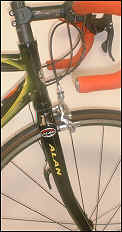 A
couple of years after I got into cycling, there was a guy in my then-club who
was known for having all the best gear. The latest trade jerseys, the savviest
equipment, the best bikes. As I remember it, he never did very much in the races
he entered, but he sure looked the part. Consequently, he earned the awe of many
of the young riders in the team.
A
couple of years after I got into cycling, there was a guy in my then-club who
was known for having all the best gear. The latest trade jerseys, the savviest
equipment, the best bikes. As I remember it, he never did very much in the races
he entered, but he sure looked the part. Consequently, he earned the awe of many
of the young riders in the team.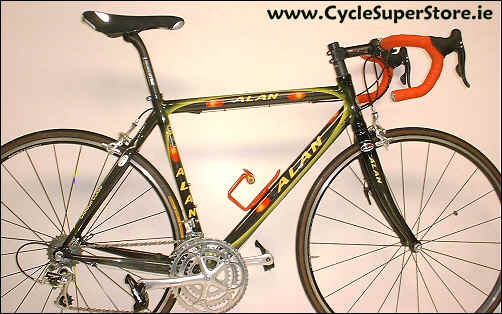
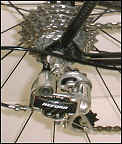 The
Campag record groupset looked great, with the carbon brake levers and derailleur
body appearing particularly classy. The finishing kit was also particularly
good, with Deda bars and stem, and a Selle Italia Turbomatic 4 set atop a Deda
Blackstick carbon seatpost. All very suave, and all contributing towards the
estimated 6,000 euro cost of the bike.
The
Campag record groupset looked great, with the carbon brake levers and derailleur
body appearing particularly classy. The finishing kit was also particularly
good, with Deda bars and stem, and a Selle Italia Turbomatic 4 set atop a Deda
Blackstick carbon seatpost. All very suave, and all contributing towards the
estimated 6,000 euro cost of the bike.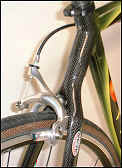 The second impression was in relation to weight; as
was expected, this bike was very light. In particular, there was minimal weight
noticeable in the back end. I have a Trek OCLV with an Ultegra groupset and Rolf
Vector Comp Wheels; picking that bike up always makes me feel the rear of the
bike is heavier than it should be, but with the Alan this was never the case.
While those two frames are probably comparable in weight, the Campagnolo Record
groupset would make a difference, and so too the Campag Neutron wheels.
The second impression was in relation to weight; as
was expected, this bike was very light. In particular, there was minimal weight
noticeable in the back end. I have a Trek OCLV with an Ultegra groupset and Rolf
Vector Comp Wheels; picking that bike up always makes me feel the rear of the
bike is heavier than it should be, but with the Alan this was never the case.
While those two frames are probably comparable in weight, the Campagnolo Record
groupset would make a difference, and so too the Campag Neutron wheels.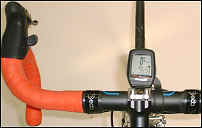 One minus for me was the shifting button on the
inside of the hoods. While I found it was comfortable to rest my hands on the
very top of the brake levers while in a stretched out position, it felt a little
awkward to have to adapt a thumb position to fit around the button. Adding to
the discomfort was the routing of the cables on the outside of the hoods; I
liked the fact that the gear cables were tucked away underneath the bar tape,
rather than the less aesthetically-pleasing Shimano route around the front of
the bike, but these cables did dig into my palms when climbing out of the
saddle. This may not be a huge deal a few minutes into a spin, but over a longer
period the discomfort is quite noticeable. Then again, this is a Campag versus
Shimano issue, rather than an Alan one.
One minus for me was the shifting button on the
inside of the hoods. While I found it was comfortable to rest my hands on the
very top of the brake levers while in a stretched out position, it felt a little
awkward to have to adapt a thumb position to fit around the button. Adding to
the discomfort was the routing of the cables on the outside of the hoods; I
liked the fact that the gear cables were tucked away underneath the bar tape,
rather than the less aesthetically-pleasing Shimano route around the front of
the bike, but these cables did dig into my palms when climbing out of the
saddle. This may not be a huge deal a few minutes into a spin, but over a longer
period the discomfort is quite noticeable. Then again, this is a Campag versus
Shimano issue, rather than an Alan one.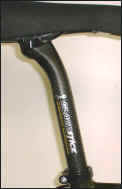 It was while checking out the upper end of the gear
spectrum that the bike really came into its own. Aided perhaps by the 175
milimetre cranks but also by the noticeable rigidity of the frame, the Alan
packed a real woooomph at higher speeds, chewing up the road once the bike was
put in the outside ring. Turning a large gear was noticeably easier than would
be expected, making this a machine which should really shine in competition. It
also makes those training ride burnups pretty satisfying.
It was while checking out the upper end of the gear
spectrum that the bike really came into its own. Aided perhaps by the 175
milimetre cranks but also by the noticeable rigidity of the frame, the Alan
packed a real woooomph at higher speeds, chewing up the road once the bike was
put in the outside ring. Turning a large gear was noticeably easier than would
be expected, making this a machine which should really shine in competition. It
also makes those training ride burnups pretty satisfying.